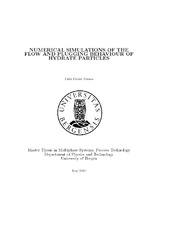Numerical simulations of the flow and plugging behaviour of hydrate particles
Master thesis
Permanent lenke
https://hdl.handle.net/1956/4229Utgivelsesdato
2010-05-06Metadata
Vis full innførselSamlinger
Sammendrag
Abstract The main hydrate mitigation used by the industry today is to avoid formation at all cost. Avoidance of hydrate formation is made possible by use of inhibitors such as methanol or glycol. These are so called thermodynamic inhibitors which change the thermodynamic conditions of the system to conditions where hydrates cannot be formed. Adding inhibitors while controlling the pressure and temperature is a very costly process. A new hydrate paradigm is evolving from avoidance of hydrates by inhibition towards risk management. In many situations it is more economical to do risk management of hydrate plugging instead of completely avoiding hydrates. Avoidance is based on thermodynamics, but risk management is based on kinetics. Today's knowledge of hydrate kinetics is not accurate enough to alone be the foundation of risk management. A combination of hydrate kinetics and operating experience must constitute this foundation today. The purpose of this work was to study the physics of hydrate particle flow in pipelines using numerical simulations. The numerical simulations were performed using ANSYS CFX, and may be compared with simulations performed in another study using STAR-CD for purposes of comparison and clearer interpretation of the physics of bed formation. In general it is important to compare simulations between software packages to destil out which flow features are due to the numerical techniques and which can be assigned to the physics of the system. Results from the numerical simulations for both softwares were compared to experimental results from a multiphase flow loop. A Eulerian-Eulerian two-fluid model was created using ANSYS CFX. Simulations in a flow regime whereby hydrate deposition was observed during experiments were performed. The apparent viscosity of the hydrate particle suspensions, which was found experimentally to follow one of the published relations for the viscosity of suspensions, was studied. A sensitivity study of the model was done for clarification of the effect of the apparent viscosity and the particle size on the model outcome.
Utgiver
The University of BergenOpphavsrett
The authorCopyright the author. All rights reserved
